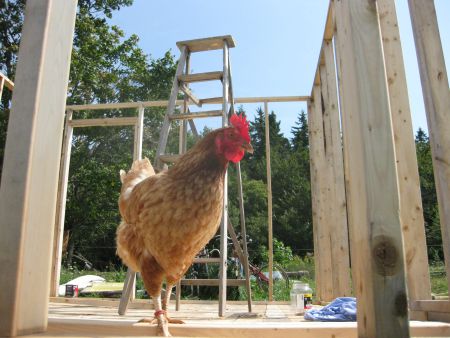Urban chickens were a hot topic this week for a large group of Halifax citizens. About 100 people filled an upstairs meeting room at City Hall on Wednesday, February 10th for the first public information meeting about potential changes to HRM zoning bylaws, changes that would legalize the ownership of a small number of laying hens in the city.
A small introductory presentation made by HRM planner Mackenzie Stonehocker was followed by 2 hours of citizens' feedback. There were speakers as young as four and as old as seventy. There was just as much diversity of opinion, ranging from passionate support to vehement opposition. Of those who spoke publicly, however, only seven people spoke against bylaw changes and more than half supported the idea of change to allow for urban chickens.
Arguments that were raised in favour of the amendment included the educational opportunities possible to children raising chickens, food security, sustainable urban living, community building, saving money, pesticide free pest control, connections to the earth and natural processes. Many success stories of other cities keeping chickens were mentioned; some attending the meeting had directly experienced the integration of poultry and urban living.
Fred Connors, of Fred Salon Cafe & Art on Agricola Street, spoke of his plans to have a small urban farm on his new Bloomfield Street property. He hopes both chickens and rabbits will be a part of his urban agriculture project. Fred recalled the controversy that surfaced when backyard composting first caught attention in the city ten years ago. Well before its integration into HRM's Naturally Green Living recommendations it was feared as the rodent beacon that many now fear backyard chickens will be.
Of those in opposition, most were the neighbours of the Hali-famous former Peninsula Chicken Keeper, Louise Hanavan. They discussed how the pre-exisiting rat problem in their neighbourhood was worsened by the presence of three chickens in the Edinburgh Street backyard. Supporters of urban chickens countered that the rat problems are not caused by the chickens themselves but by mismanagement of chicken feed and poor coop structure design, similar to problems caused by exposed bird feeders and irresponsible household food storage. Other concerns of those against bylaw changes were noise, smell, small lot sizes and home resale values in the event of a rat pandemic.
It seems likely that lot size will be included in any bylaw change that occurs. If this is the case, lot size will be used to determine how many chickens a household can keep. It may also mean that many lots will not be eligible at all. One concern raised by Garity Chapman, the Ecology Action Centre's Urban Garden Co-ordinator, is that a minimum lot size could disproportionately affect people with lower incomes living on smaller lots. Another accessibility concern is that only homeowners will have access to Poultry Permits and not renters.
A report on the meeting will be tabled before the Peninsula Community Council (PCC) in the upcoming months. This report will make recommendations for or against amending the HRM Peninsula current land-use by-laws. The PCC will then decide whether or not to push amendments forward. At this time another public hearing will occur.
For those unable to attend the meeting more information and a public survey are available online. The survey must be submitted before March 1st. The feedback will shape the amendment proposal that will be presented to the Peninsula Community in the upcoming months.




